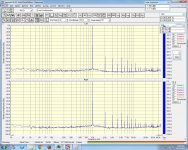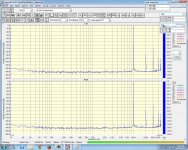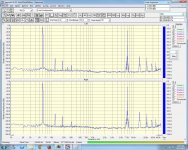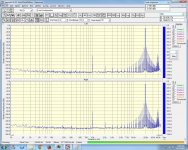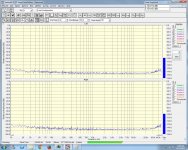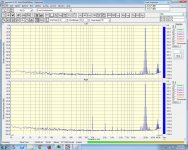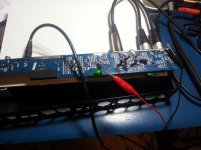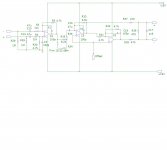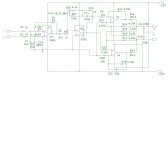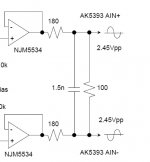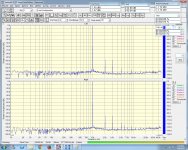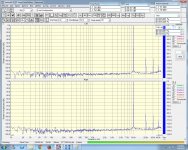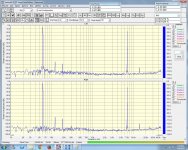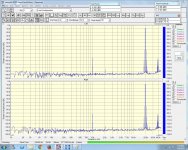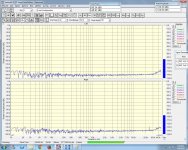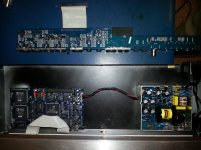Behringer DEQ2496 is well known cheap audio processor, which was on the market for almost 10 years . Now you can find even more impressive devices like made by MiniDSP ot DSPeaker, but they are more expensive too and for some applications are less flexible. DEQ2496 was (and likely still is) considered a best bang for the buck digital processor that packs a lot of goodies - parametric and graphic equalizers, dynamic compressor/expander, dynamic equalizer, limiter, stereo field expander, ADC and DAC with 24/96 sampling. All these features can be used in parallel and stacked on each other. That is why a lot of DIYs use it for things like room correction. But at the same time it is known that it sounds good only when used as purely digital processor bypassing internal ADC and DAC.
I bought one of this devices via Craigslist few years ago with a goal to suppress some modes in my music room. I tried it there between pre- and power amplifier, but felt that it was not transparent enough comparing with the rest of my audio chain. I also tried it between digital transport and preamplifier and felt that it is better works that way, but considering that I use analog sources too, I couldn't really use it. So Behringer went on a shelf, and stayed there for almost two years. Recently I decided to give it another try, this time not in stock form and shape.
But what is exactly wrong with analog to digital and digitral to analog processing in DEQ2496? Several people measured performance of DEQ2496 in analog domain and found it unsatisfactory. One example you can find here: Archimago's Musings: MEASUREMENTS: Behringer DEQ2496. As you can see numbers (other than jitter) do not look too bad. But more serious problem can be found from measurements on this page Behringer Mods - Upgrade DEQ2496, DCX2496, SRC2496 It is clear that DEQ2496 has very high level of IMD at high frequencies. Picture shows that odd order intermodulation harmonics reach -70dB level - that should and is considered very poor for modern device. I did similar series of measurements myself . I used SpectraPlus 5 software and old, but still excellent EMU 0404USB audio interface (Archimago from link above used it too). EMU has distortion level many times less than DEQ2496, thus my results were not significantly affected by its own distortions. Below you can find distortion spectrum for 1 and 10 kHz tones, 19+20 kHz and 60+7000 Hz IMD test signals and silent test. All these tests were done through main analog inputs and outputs of DEQ2496 running at 96 kHz sampling rate. I also added 19+20 kHz loopback test of EMU interface as a reference.
From pictures you can see that Behringer has high level of harmonic and IM distortion for high frequency signals. Worst distortion spectrum can be observed in 19+20 kHz IMD test, with distortion levels more than 0.1% and odd order harmonics reaching -65 dB. There is no surprise that Behringer sounded rather poorly when used with analog inputs and outputs. As a comparison I did another test in digital domain and as expected there were almost no distortion observed. On the surface DEQ2496 uses high quality Asahi Kasei chips which should provide very low distortion. They are commonly used in studio gear 10 times more expensive than Behringer device. Thus if this is not about actual A/D and D/A chips, then it should be analog part, right?
I bought one of this devices via Craigslist few years ago with a goal to suppress some modes in my music room. I tried it there between pre- and power amplifier, but felt that it was not transparent enough comparing with the rest of my audio chain. I also tried it between digital transport and preamplifier and felt that it is better works that way, but considering that I use analog sources too, I couldn't really use it. So Behringer went on a shelf, and stayed there for almost two years. Recently I decided to give it another try, this time not in stock form and shape.
But what is exactly wrong with analog to digital and digitral to analog processing in DEQ2496? Several people measured performance of DEQ2496 in analog domain and found it unsatisfactory. One example you can find here: Archimago's Musings: MEASUREMENTS: Behringer DEQ2496. As you can see numbers (other than jitter) do not look too bad. But more serious problem can be found from measurements on this page Behringer Mods - Upgrade DEQ2496, DCX2496, SRC2496 It is clear that DEQ2496 has very high level of IMD at high frequencies. Picture shows that odd order intermodulation harmonics reach -70dB level - that should and is considered very poor for modern device. I did similar series of measurements myself . I used SpectraPlus 5 software and old, but still excellent EMU 0404USB audio interface (Archimago from link above used it too). EMU has distortion level many times less than DEQ2496, thus my results were not significantly affected by its own distortions. Below you can find distortion spectrum for 1 and 10 kHz tones, 19+20 kHz and 60+7000 Hz IMD test signals and silent test. All these tests were done through main analog inputs and outputs of DEQ2496 running at 96 kHz sampling rate. I also added 19+20 kHz loopback test of EMU interface as a reference.
From pictures you can see that Behringer has high level of harmonic and IM distortion for high frequency signals. Worst distortion spectrum can be observed in 19+20 kHz IMD test, with distortion levels more than 0.1% and odd order harmonics reaching -65 dB. There is no surprise that Behringer sounded rather poorly when used with analog inputs and outputs. As a comparison I did another test in digital domain and as expected there were almost no distortion observed. On the surface DEQ2496 uses high quality Asahi Kasei chips which should provide very low distortion. They are commonly used in studio gear 10 times more expensive than Behringer device. Thus if this is not about actual A/D and D/A chips, then it should be analog part, right?
Attachments
Last edited:
Another (ultimate?) Behringer mod - what can $50 do to DEQ2496 (PART 2)
So what can be done to improve quality of audio processing in Behrigner? There are many modding options offered by people. Examples are Behringer Mods - Upgrade DEQ2496, DCX2496, SRC2496 , AW DIY - Audio designs for the DEQ2496 and DCX2496 , Behringer DEQ2496 DAC Direct Out mod | MiniRIG and many others. The common approach is to COMPLETELY REPLACE analog board with another one, often loosing features like logical and physical bypass and trim level adjustment. Extreme options included replacing electronics with output transformer or adding tubes like proposed here Ultracurve
There is no service manual or schematic of DEQ2496 publicly available. Behringer makes similar device – digital crossover DCX2496. There is schematic available for that unit. Apparently Behringer uses similar analog circuits in both processors. Thus I started with known schematic of DCX and compared it with DEQ. There is only minor difference in components values and additional part of circuit that is needed for bypass (through relays) and input/output trim level switch in DEQ. Pictures below represent slightly simplified analog part of DEQ2496 that serves as main input and output circuits. These circuit are not really optimal – one can do much better using specialized differential amplifiers available today for both input and output, like an excellent LME49724. But 10 years ago when original DEQ circuit was likely designed it made more economic sense to use simple JRC4580 opamps.
There is one serious problem with this circuit though. You can see that there are electrolytic capacitors in signal path. Behringer uses polarized capacitors in circuit where not much of offset voltage is applied to them. Usually bi-polar capacitors are used under that condition. I cannot explain why Behringer made this choice. Neither could author from http://www.awdiy.com who proposed to upgrade both opamps and electrolytic capacitors. That made sense to me and I decided to start with this component upgrade. Cost of DYI project like this is expected to be under $50.
I followed recommendation on site mentioned above and ordered LM4562 for input circuit and OPA2134 for output circuit. Both were a reasonable choice to me. For coupling capacitors I ordered Nichicon Muse bi-polar ones. Following recommendation I also ordered few Nichicon UHD (low ESR) capacitors to replace ones used in power rails bypass around ADC and DAC chips. Total order was under $40 from Mouser.
Few days later package arrived and I started upgrade work. There is some problem with replacing capacitors though: originals used by Behringer are rather small, and Nichicon bi-polars are much larger in size. Thus do not fit well in original location. I had to move them a bit keeping leads longer. There is a possibility of catching noise from EMI with these long legs, but there was nothing I could do about it. I follow recommendation here AW DIY - Capacitors upgrade in replacing capacitors. Replacing opamps was much harder task. Behringer for unknown reason decided to glue opamps to the circuit board. In light of that I couldn't use my rework heat gun to desolder them. In the end I used Dremel tool with cutting disk to cut off legs with a small piece of opamp body and de-soldered it using wide iron tip. After that by applying sufficient force with pliers I was able to remove remnants of opamp body from board by cracking the glue. Then I carefully soldered new opamps – LM4563 in input and OPA2134 in output circuits. Despite my best effort I ended up damaging a couple of solder pads and had to repair them using 32ga wire.
Finally everything was ready and I ran tests again hoping see great improvement. To my surprise when I ran 19+20 kHz IMD test – I saw the picture not much different from original one. Even if there was some improvement, I did not see what I hoped for. There was still too much odd order harmonics around fundamental frequencies. Thus upgrade attempt was practically a failure.
So what can be done to improve quality of audio processing in Behrigner? There are many modding options offered by people. Examples are Behringer Mods - Upgrade DEQ2496, DCX2496, SRC2496 , AW DIY - Audio designs for the DEQ2496 and DCX2496 , Behringer DEQ2496 DAC Direct Out mod | MiniRIG and many others. The common approach is to COMPLETELY REPLACE analog board with another one, often loosing features like logical and physical bypass and trim level adjustment. Extreme options included replacing electronics with output transformer or adding tubes like proposed here Ultracurve
There is no service manual or schematic of DEQ2496 publicly available. Behringer makes similar device – digital crossover DCX2496. There is schematic available for that unit. Apparently Behringer uses similar analog circuits in both processors. Thus I started with known schematic of DCX and compared it with DEQ. There is only minor difference in components values and additional part of circuit that is needed for bypass (through relays) and input/output trim level switch in DEQ. Pictures below represent slightly simplified analog part of DEQ2496 that serves as main input and output circuits. These circuit are not really optimal – one can do much better using specialized differential amplifiers available today for both input and output, like an excellent LME49724. But 10 years ago when original DEQ circuit was likely designed it made more economic sense to use simple JRC4580 opamps.
There is one serious problem with this circuit though. You can see that there are electrolytic capacitors in signal path. Behringer uses polarized capacitors in circuit where not much of offset voltage is applied to them. Usually bi-polar capacitors are used under that condition. I cannot explain why Behringer made this choice. Neither could author from http://www.awdiy.com who proposed to upgrade both opamps and electrolytic capacitors. That made sense to me and I decided to start with this component upgrade. Cost of DYI project like this is expected to be under $50.
I followed recommendation on site mentioned above and ordered LM4562 for input circuit and OPA2134 for output circuit. Both were a reasonable choice to me. For coupling capacitors I ordered Nichicon Muse bi-polar ones. Following recommendation I also ordered few Nichicon UHD (low ESR) capacitors to replace ones used in power rails bypass around ADC and DAC chips. Total order was under $40 from Mouser.
Few days later package arrived and I started upgrade work. There is some problem with replacing capacitors though: originals used by Behringer are rather small, and Nichicon bi-polars are much larger in size. Thus do not fit well in original location. I had to move them a bit keeping leads longer. There is a possibility of catching noise from EMI with these long legs, but there was nothing I could do about it. I follow recommendation here AW DIY - Capacitors upgrade in replacing capacitors. Replacing opamps was much harder task. Behringer for unknown reason decided to glue opamps to the circuit board. In light of that I couldn't use my rework heat gun to desolder them. In the end I used Dremel tool with cutting disk to cut off legs with a small piece of opamp body and de-soldered it using wide iron tip. After that by applying sufficient force with pliers I was able to remove remnants of opamp body from board by cracking the glue. Then I carefully soldered new opamps – LM4563 in input and OPA2134 in output circuits. Despite my best effort I ended up damaging a couple of solder pads and had to repair them using 32ga wire.
Finally everything was ready and I ran tests again hoping see great improvement. To my surprise when I ran 19+20 kHz IMD test – I saw the picture not much different from original one. Even if there was some improvement, I did not see what I hoped for. There was still too much odd order harmonics around fundamental frequencies. Thus upgrade attempt was practically a failure.
Last edited:
Another (ultimate?) Behringer mod - what can $50 do to DEQ2496 (PART 3)
Now I sat and thought: what are my options? I didn't want to buy upgrade boards which would cost as much as I paid for DEQ device (remember I got it used for well under $200). Trying to understand what is wrong I entered schematic of output board into Microcap and run simulation. There was nothing suspicious. Microcap reported that distortion level should be much lower than what I saw in real life. So I went back to test bench. This time I decided to test distortion in different parts of circuit on a path from DAC chip to output terminals. To exclude influence of ADC part, I fed DEQ via its digital input and probed signal using one of EMU interface inputs, using it in Hi-Z mode via 47uF capacitor to protect from any offset voltages in circuit. I used one of spare Muse capacitors for that. When I probed output of DAC chip – there was very little distortion, but already at output of first opamp (pin 7, see circuit picture) distortion was much higher. Considering that 2134 opamp is natively a low distortion device loaded by relatively high value resistors, the only other source of distortion could be capacitors. There were three of them – all apparently ceramics in 0805 and smaller form factors. That gave me a clue – could it be that Behringer used high-K ceramic capacitors known by their poor linearity instead of something more appropriate for audio? Decision came quickly to try replace them with high quality ones and test again. I didn't have any SMT capacitors on hand at that time, so I just removed chips and soldered polystyrene ones on their long flexible legs. When I looked at distortion analyzer screen after this change – it was night and day difference. Distortion at the output of first stage was only barely higher than at output of DAC chip. Now I decided to go forward and replace capacitors in floating output amplifier stage, Second channel I left unchanged as a reference. After new capacitors all were in place I tested DEQ again. Distortion level was much lower than anything I saw before.
Now I new that poor quality ceramic capacitors are the root cause. I couldn't leave polystyrene capacitors – they are too big and cannot fit on analog board (see picture of analog board on by bench). The only real option was to replace ceramics with high quality film capacitors of the same or similar size. After some research I decided to use Polyphenylene Sulfide (PPS) type made by Panasonic. I found them in stock at Digi-Key and ordered all different values I found in circuit. The only one value I couldn't find of film type – 20pf. For that I ordered High-Q ceramic capacitor manufactured by Murata.
Few days later package arrived and I spend evening replacing capacitors on the analog board. I only worked with part of circuit that serves main inputs and outputs and kept axillary output stock for reference (it was Ok for me, since I had no plans to use it anyway). When all work was completed I ran end to end test using analog inputs and outputs. Distortion level was much lower than before change, but again not as low as I hoped.
Now I sat and thought: what are my options? I didn't want to buy upgrade boards which would cost as much as I paid for DEQ device (remember I got it used for well under $200). Trying to understand what is wrong I entered schematic of output board into Microcap and run simulation. There was nothing suspicious. Microcap reported that distortion level should be much lower than what I saw in real life. So I went back to test bench. This time I decided to test distortion in different parts of circuit on a path from DAC chip to output terminals. To exclude influence of ADC part, I fed DEQ via its digital input and probed signal using one of EMU interface inputs, using it in Hi-Z mode via 47uF capacitor to protect from any offset voltages in circuit. I used one of spare Muse capacitors for that. When I probed output of DAC chip – there was very little distortion, but already at output of first opamp (pin 7, see circuit picture) distortion was much higher. Considering that 2134 opamp is natively a low distortion device loaded by relatively high value resistors, the only other source of distortion could be capacitors. There were three of them – all apparently ceramics in 0805 and smaller form factors. That gave me a clue – could it be that Behringer used high-K ceramic capacitors known by their poor linearity instead of something more appropriate for audio? Decision came quickly to try replace them with high quality ones and test again. I didn't have any SMT capacitors on hand at that time, so I just removed chips and soldered polystyrene ones on their long flexible legs. When I looked at distortion analyzer screen after this change – it was night and day difference. Distortion at the output of first stage was only barely higher than at output of DAC chip. Now I decided to go forward and replace capacitors in floating output amplifier stage, Second channel I left unchanged as a reference. After new capacitors all were in place I tested DEQ again. Distortion level was much lower than anything I saw before.
Now I new that poor quality ceramic capacitors are the root cause. I couldn't leave polystyrene capacitors – they are too big and cannot fit on analog board (see picture of analog board on by bench). The only real option was to replace ceramics with high quality film capacitors of the same or similar size. After some research I decided to use Polyphenylene Sulfide (PPS) type made by Panasonic. I found them in stock at Digi-Key and ordered all different values I found in circuit. The only one value I couldn't find of film type – 20pf. For that I ordered High-Q ceramic capacitor manufactured by Murata.
Few days later package arrived and I spend evening replacing capacitors on the analog board. I only worked with part of circuit that serves main inputs and outputs and kept axillary output stock for reference (it was Ok for me, since I had no plans to use it anyway). When all work was completed I ran end to end test using analog inputs and outputs. Distortion level was much lower than before change, but again not as low as I hoped.
Attachments
Last edited:
Another (ultimate?) Behringer mod - what can $50 do to DEQ2496 (PART 4)
What was a problem this time? Both input and output analog sections should have low distortion now. Is there a problem with ADC, DAC or digital processing itself? Latter can be easily excluded by testing DEQ in pure digital mode. I did that and didn't find any significant distortion. Good thing is that DEQ also offers both analog input to digital output, and digital input to analog output modes of operation. That allows to check ADC and DAC sections separately. I started with DAC (using digital input, and analog output) and found very low distortion. So that was ADC after all. I confirmed that feeding DEQ analog signal and monitoring distortion of digitized signal at its digital output. But what is a root cause? I again probed circuit and found low distortion level at output of two opamps which feed ADC chip. But there was much higher distortion at input pins of ADC chip itself. I traced circuit on analog board and found that though there is nothing between opamps on analog board and board to board cable, digital processing board has some additional analog circuit before ADC chip. This circuit can be found in a datasheet of ADC chip AK5395. This is a circuit that includes three resistors and one capacitor between opamps that feed ADC and ADC input pins (see picture). In Behringer this circuit is located on digital processing board. Here we again see relatively high value ceramic capacitor. I didn't have 1500pF SMT capacitors on hand and didn't want to delay my project again by ordering new ones (and paying another shipping charge for just a pair of them) and decided to use available polypropylene type designed for through hole assembly. I soldered them to pads after removing ceramic chips.
With that done., I tested ADC again and finally found reasonably low distortion. Now everything was ready for final testing. And I did it end to end: from analog input to analog output. Results you can see below. It is clear that I achieved great improvement with IMD distortion level lowered 20 fold from more than 0.1% to almost 0.006%. You can see analog and digital boards with new capacitors and opamps on photo below. Total budget was about $70. I strongly believe that opamps replacement was not really necessary and I could save on that and thus bring components cost down to $50.
Overall the lesson from that exercise was that main problem with DEQ2496 was poor choice of ceramic capacitors in analog board, and with only $50 in new parts and few hours of spare time performance of Behringer device can be greatly improved. DEQ2496 is not the only device using this type of circuit. DCX2496 electronic crossover is very popular among DIY speaker makers. It is likely that device can be very economically improved too, bringing it to a very different quality level all way up to to high-end performance.
Now it is time for listening tests. But this will be a different story.
What was a problem this time? Both input and output analog sections should have low distortion now. Is there a problem with ADC, DAC or digital processing itself? Latter can be easily excluded by testing DEQ in pure digital mode. I did that and didn't find any significant distortion. Good thing is that DEQ also offers both analog input to digital output, and digital input to analog output modes of operation. That allows to check ADC and DAC sections separately. I started with DAC (using digital input, and analog output) and found very low distortion. So that was ADC after all. I confirmed that feeding DEQ analog signal and monitoring distortion of digitized signal at its digital output. But what is a root cause? I again probed circuit and found low distortion level at output of two opamps which feed ADC chip. But there was much higher distortion at input pins of ADC chip itself. I traced circuit on analog board and found that though there is nothing between opamps on analog board and board to board cable, digital processing board has some additional analog circuit before ADC chip. This circuit can be found in a datasheet of ADC chip AK5395. This is a circuit that includes three resistors and one capacitor between opamps that feed ADC and ADC input pins (see picture). In Behringer this circuit is located on digital processing board. Here we again see relatively high value ceramic capacitor. I didn't have 1500pF SMT capacitors on hand and didn't want to delay my project again by ordering new ones (and paying another shipping charge for just a pair of them) and decided to use available polypropylene type designed for through hole assembly. I soldered them to pads after removing ceramic chips.
With that done., I tested ADC again and finally found reasonably low distortion. Now everything was ready for final testing. And I did it end to end: from analog input to analog output. Results you can see below. It is clear that I achieved great improvement with IMD distortion level lowered 20 fold from more than 0.1% to almost 0.006%. You can see analog and digital boards with new capacitors and opamps on photo below. Total budget was about $70. I strongly believe that opamps replacement was not really necessary and I could save on that and thus bring components cost down to $50.
Overall the lesson from that exercise was that main problem with DEQ2496 was poor choice of ceramic capacitors in analog board, and with only $50 in new parts and few hours of spare time performance of Behringer device can be greatly improved. DEQ2496 is not the only device using this type of circuit. DCX2496 electronic crossover is very popular among DIY speaker makers. It is likely that device can be very economically improved too, bringing it to a very different quality level all way up to to high-end performance.
Now it is time for listening tests. But this will be a different story.
Attachments
Last edited:
Some excellent investigation there! 
So in a nutshell, the main cause of excessive HF IMD is two 2n2 ceramics and one 1n5 per DAC and another 1n5 per ADC channel, which can be replaced by decent films (e.g. (metallized) PP) for pennies?
(I am assuming everything 390p and under is NP0, which is usually the case.)
If that isn't a major bang/buck mod I don't know what is.
Yeah, I guess it'll be better with the new opamps, and standard polarized 'lytics with no bias voltage are a ticking timebomb if nothing else (and ideally replaced by a "low leakage" type - Vishay BCComponents 013 RLC, Elna RLB, whatever). Still, about an order of magnitude of improvement from just a handful of cheap passives? Sounds like a no-brainer.
So in a nutshell, the main cause of excessive HF IMD is two 2n2 ceramics and one 1n5 per DAC and another 1n5 per ADC channel, which can be replaced by decent films (e.g. (metallized) PP) for pennies?
(I am assuming everything 390p and under is NP0, which is usually the case.)
If that isn't a major bang/buck mod I don't know what is.
Yeah, I guess it'll be better with the new opamps, and standard polarized 'lytics with no bias voltage are a ticking timebomb if nothing else (and ideally replaced by a "low leakage" type - Vishay BCComponents 013 RLC, Elna RLB, whatever). Still, about an order of magnitude of improvement from just a handful of cheap passives? Sounds like a no-brainer.
Last edited:
390pF and even 100pF capacitors are equally bad in that unit. I do not know if designer didn't understand what he is doing when specified that type of ceramics, or contract manufacturer in China decided to save few pennies on each unit. But ALL ceramic capacitors should be replaced in Behringer (with likely the only exception of 0.1uF used in power rails decoupling). It is still is a cheapest mod I know, and results are objectively excellent.
Bummer. That's a fair few more to replace. I guess they used the cheapest caps they could find. I didn't know 100 pF ceramic caps in anything not NP0 even existed.390pF and even 100pF capacitors are equally bad in that unit.
Has anyone tried a re-cap only mod?
Has anyone here heard of one, that I could read about?
I'm thinking of getting one, and it would be interesting to see how cheap you can go with modding, and still get quality results. After all, there are good and pretty cheap DACs out there. And there are cheap ADCs, I just dont know how good they are.
If you can get similar or better peformance, with cheap DACs and ADCs, it might not be worth the time and cost to mod this device.
Has anyone here heard of one, that I could read about?
I'm thinking of getting one, and it would be interesting to see how cheap you can go with modding, and still get quality results. After all, there are good and pretty cheap DACs out there. And there are cheap ADCs, I just dont know how good they are.
If you can get similar or better peformance, with cheap DACs and ADCs, it might not be worth the time and cost to mod this device.
Well, I just bought a DEQ2496, and I would certainly embark on this caps mod as per your findings... It would be really useful if we had a list of the ceramic caps to be changed (C5, C6, on main board, C11, C12 on I/O board, etc...) along with their value, so we know exactly what to order and what to change. Here on the board I got, values are very hard to read.
OK! I just finished a partial/essential caps mod. In the absence of definitive info, I was shooting in the dark somewhat, but here is what I did: On analog board, replaced 2n2 caps labeled C68, C68, C12 and C15 with Panasonic film caps from Digi-key. replaced 390p caps labeled C66, C67, C69 and C78 with Panasonic film yadda yadda replaced the 9 47uF electrolytics near the relays with new Nichicons from DigiKey Although I had spotted one 220p cap per channel on output schematic (labeled C5) and I had ordered some, I could not find any on board, so none were replaced... Nor did I change any 100p (for monetary reasons) or any other value not stated caps, or any opamps. On digital board: replaced 1n5 caps labeled C18 and C19 with Panasonic film yadda yadda added 10uF bypass caps on C30, C31 and C32 positions. that was the hardest godawful soldering job I hadn't done in a while! My equipment is really not up to par for soldering 0805 SMTs on already populated boards... That's all I have to say, really: I have not listened to the DEQ yet, and I would be hard pressed to spot any differences in the sound since I only used this device once without the mods. Furtermore, I am not equipped to make measurements... Total cost was $22.25 cdn, including the $8 shipping fee.
Old thread I know, but it's a good one! Useful threads can outlive new posts from their contributors. Is there any chance we can turn this into an easier to follow step-by-step guide? I am trying to do this right now but the info here is sort of disjointed and hard to follow. Pics are too small to see more identifying info. I could use an itemized list and the specific part numbers here and the exact cap locations they are replacing. Otherwise, there's just not quite enough procedural info here to know what's actually going on and make it happen for the average modder.
My DEQ2496 is arriving on Tuesday and my smaller diameter soldering tips arrived today.
I'll have to open her up and take a first hand look at the board to translate the diagrams that avp1 uploaded, and unless I'm mistaken, we don't have a diagram of the digital board, just the analog in and analog out (maybe the digital board that PierOlo mentions is the diagram of the dac chip?).
With the analog diagrams and PierOlo's specific list of caps (the C2 C15 etc that you can match up to the diagrams), we should be on the right track.
There is also the diagram of the dac itself which shows the location of another capacitor (two? one on each side) - that might be the digital part that PierOlo mentions.
Then there are the 100p capacitors that PierOlo didnt swap that I might try and identify.
Either way, I'll have to take a look at the board before I commit to buying caps. I'll take pictures and draw on them to show the exact locations. Hope you don't mind waiting! (Hopefully the caps will only take a 5-10 days to arrive, assuming I can avoid international sellers).
Best case, I'll start on March 18th. Worst case the week or two after that.
I'll have to open her up and take a first hand look at the board to translate the diagrams that avp1 uploaded, and unless I'm mistaken, we don't have a diagram of the digital board, just the analog in and analog out (maybe the digital board that PierOlo mentions is the diagram of the dac chip?).
With the analog diagrams and PierOlo's specific list of caps (the C2 C15 etc that you can match up to the diagrams), we should be on the right track.
There is also the diagram of the dac itself which shows the location of another capacitor (two? one on each side) - that might be the digital part that PierOlo mentions.
Then there are the 100p capacitors that PierOlo didnt swap that I might try and identify.
Either way, I'll have to take a look at the board before I commit to buying caps. I'll take pictures and draw on them to show the exact locations. Hope you don't mind waiting! (Hopefully the caps will only take a 5-10 days to arrive, assuming I can avoid international sellers).
Best case, I'll start on March 18th. Worst case the week or two after that.
Analog board: the one in the back with the connectors and input/output drivers. You have to remove it, because the components we're interested in are underneath.
Digital board: the main board with the A/D, D/A and signal processors and controller. All the parts we're concernes with are on the top.
Once you know which is the analog, and which is the digital board, it's pretty easy to identify the suspects. Just follow the parts numbers I gave. If youre lucky, the silkscreening will be legible. You'll even be able to know which value a particular cap is, it' marked!
Mind you, I's not always very clear or legible: you have to use loupes to make it out.
Digital board: the main board with the A/D, D/A and signal processors and controller. All the parts we're concernes with are on the top.
Once you know which is the analog, and which is the digital board, it's pretty easy to identify the suspects. Just follow the parts numbers I gave. If youre lucky, the silkscreening will be legible. You'll even be able to know which value a particular cap is, it' marked!
Mind you, I's not always very clear or legible: you have to use loupes to make it out.
- Home
- Source & Line
- Digital Line Level
- Another (ultimate?) Behringer mod - what can $50 do to DEQ2496 (PART 1)
